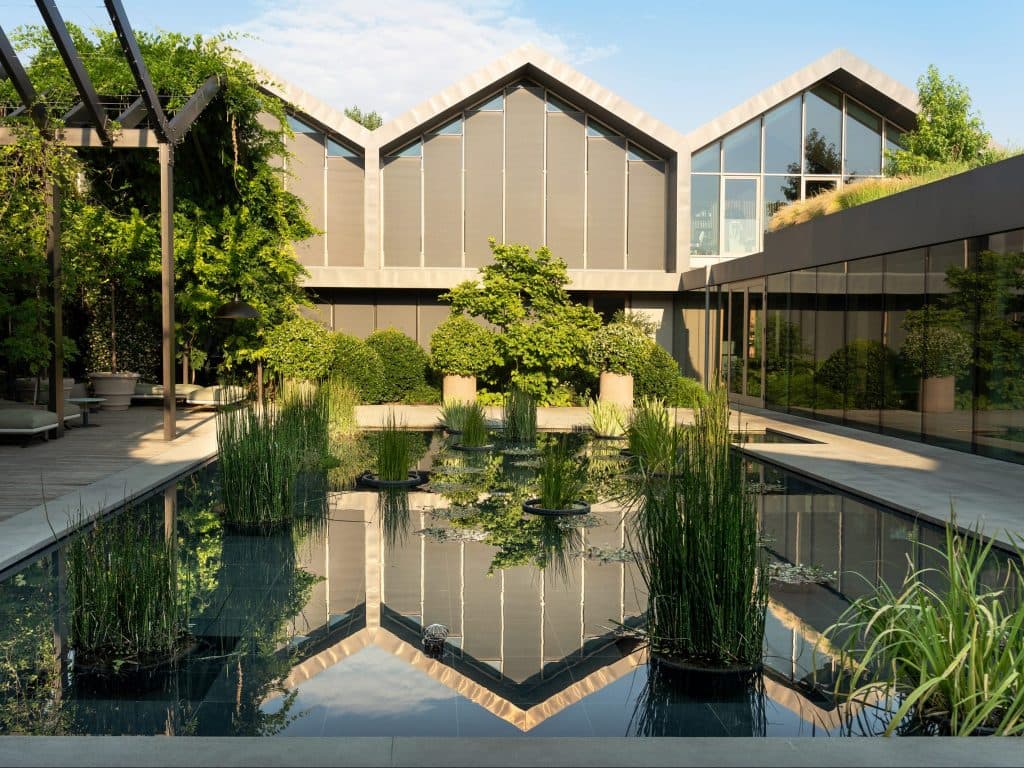Walk through the doors of the Davines headquarters – or, as they call it, the Davines Village – and you’re struck with something quite peculiar. Namely, you wonder if you might have just joined some kind of cult. The building actually reads a bit like the one in Severance, though it’s less dystopian nightmare (or a hit-you-over-the-head metaphor for capitalism), and more people a state of the art architectural project, full of people leisurely milling about, taking their time sipping tiny coffees.
It’s the kind of fare that’s only really possible if you’re working for a company that’s making a very real, tangible difference in the beauty sphere. It probably also helps that the building is surrounded by the fields of Parma, and has been carefully constructed so employees can always see the outside world — that, by the way, includes a lily-strewn pond with a single koi swimming around. You can kind of imagine it jumping out, growing a really dainty pair of legs, and telling you something else amazing that Davines does. He’s probably fed with carbon-neutral, organic fish food. Is he even real? I’m not sure. It’s all a bit like a dream, or a really pleasant mushroom trip.

But I digress. The point of this article is that if Davines were a cult (they’re not, just to clarify) you’d find it difficult to not leave your loved ones and go join them — because what started out as a humble cosmetics lab founded by the Bollati Family back in 1983 has evolved into something else entirely. Most exciting (and I’m not being even hyperbolic) is their work within regenerative beauty.
While most beauty brands are still congratulating themselves for slapping “sustainable” or “organic” on their packaging, Davines is fundamentally rethinking the relationship between beauty products and the planet. The B Corp certified brand (they’ve been part of that movement since back in 2016, by the way) isn’t just trying to do less harm. They’re actively working to reverse environmental damage through regenerative agriculture. At the heart of that mission is EROC (the European Regenerative Organic Center), established in 2021 through a partnership between Davines Group and Rodale Institute, who are the global leader in regenerative organic agriculture research. It’s a 17-hectare living laboratory beyond the Davines Villages’ main grounds that manages to make a load of (seemingly barren) fields very interesting — without being too inflated about it, it’s the kind of unassuming scenery that’s transforming how beauty ingredients are sourced.

EROC consists of 136 experimental plots where 17 different plant species are grown in rotation following regenerative organic principles. Those (minimal soil disturbance, crop rotation, organic fertilisers, and the promotion of biodiversity) are deceptively simple, but the impact is profound. They sequester more carbon, rebuild soil health, preserve water quality, and create hardy agricultural systems that help fight climate change rather than contribute to it.
All of this sounds very impressive on paper, but it’s another thing entirely to see it in action. That’s why we find ourselves being led through Davines’ Scientific Garden and greenhouse by Simon Jackson, their head of botanical research. There’s a lot to take in. Pesticides come in the form of ladybirds — they, of course, use nature’s own pest control system rather than chemical pesticides. It’s the kind of detail that makes you think whoever’s in charge here must be perpetually asking, “But is there an even more wholesome way we could do this?” Perhaps that’s what the lone koi does.

What sets Davines apart is their concept of “activist ingredients” — botanical extracts grown using regenerative organic methods that become the bread and butter of their products. “Smell this,” Simon says with infectious enthusiasm, thrusting a handful of freshly plucked yarrow under our noses. He has an encyclopedic knowledge of every leaf, stem, and flower growing here.
“This is yarrow,” he explains as we dutifully inhale. Simon reels off botanical facts that (without fail) connect to one of the products we were introduced to earlier. White yarrow extract, for example, finds its way into their “WE STAND/for regeneration” hair and body wash bar — it’s 99.7% biodegradable, packaged in 100% recyclable paper, and contains ingredients cultivated at, you guessed it, EROC. It’s the same slew of credentials (which, for Davines, seem like the bare minimum) employed in the hair, body, and face butter they put out last year, which is all about the organic calendula they’ve grown at EROC.

It doesn’t come as too much of a surprise that they’re going ham on the EROC messaging — last year, it earned itself a Regenerative Organic Certification®. The ostensible gold standard within that world, it guarantees farms and products meet the highest standards for soil health, animal welfare, and farmworker fairness. Obviously, it’s not one that’s handed out willy-nilly.
In the weeks that follow my trip to Parma, I find myself going to not one but two salons using Davines products. Are they as lovestruck by the whole ethos as I am? Even though they haven’t traipsed through a sunny field with a botanist that’s insistent on repeatedly shunting some herbs under your nostrils? They are. Obviously.

And is regenerative beauty the new organic? Davines certainly thinks so, and after seeing their operation firsthand, it’s hard to disagree. The beauty industry has long promised transformation in a bottle — but Davines is delivering transformation that starts in the soil and extends far beyond your hair or skin. That’s a cult I can get behind.




